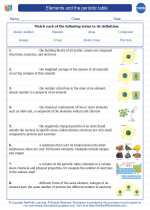Behavioral Adaptations
Behavioral adaptations are the actions, reactions, and activities an organism carries out to increase its chances of survival and reproduction in a given environment. These adaptations are developed over time through the process of natural selection, where organisms with certain behaviors that are advantageous in a particular environment are more likely to survive and pass on their genes to the next generation.
Examples of Behavioral Adaptations
1. Migration: Many species of birds and mammals migrate to different regions based on changes in food availability, climate, or breeding patterns.
2. Hibernation: Some animals, such as bears and certain rodents, hibernate during the winter to conserve energy when food is scarce.
3. Camouflage: Prey animals may exhibit behaviors that help them blend into their surroundings, making it harder for predators to spot them.
4. Communication: Many species use various forms of communication, such as vocalizations, body language, and chemical signals, to convey information to others in their group or to attract mates.
Study Guide
Here are some key points to focus on when studying behavioral adaptations:
- Understand the concept of natural selection and how it relates to the development of behavioral adaptations.
- Learn about specific examples of behavioral adaptations in different animal species, including migration, hibernation, and communication behaviors.
- Explore the advantages of particular behavioral adaptations in specific environments and how they contribute to an organism's survival and reproductive success.
- Consider the role of behavioral adaptations in the broader context of an organism's overall survival strategy, including physical and physiological adaptations.
- Examine the potential impact of human activities, such as habitat destruction and climate change, on the ability of organisms to exhibit their natural behavioral adaptations.
Understanding behavioral adaptations provides valuable insights into the ways in which organisms have evolved to thrive in diverse environments, and the complex interactions between behavior, ecology, and evolution.
.◂Chemistry Worksheets and Study Guides High School. Elements and the periodic table

 Worksheet/Answer key
Worksheet/Answer key
 Worksheet/Answer key
Worksheet/Answer key
 Vocabulary/Answer key
Vocabulary/Answer key
 Vocabulary/Answer key
Vocabulary/Answer key
 Vocabulary/Answer key
Vocabulary/Answer key
